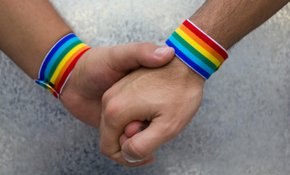Do you think it is acceptable for television programmes such as soap operas to broadcast scenes of couples kissing briefly in bed? What about if the individuals in question were married? Not married? What about if it was two gay men? Or two lesbian women? Would this be OK for broadcast pre-or-post watershed, or, in fact, not at all?
Our recent poll put these questions to the British public*, and found that Brits are generally accepting of most types of couple in this situation, with relatively few people saying that the scenes in question should never be broadcast. However, tolerance levels towards scenes involving homosexual couples still have some way to go before equalising with feelings towards straight couple scenes.
Whether the two straight people involved are ‘married’ makes little difference to the overall perceived acceptability, but a scene showing a lesbian couple is moderately better-received than one showing gay men: more people think a lesbian scene would be acceptable post-9pm watershed than a gay male one.
Older people over 60 are much less tolerant towards homosexual scenes than their younger counterparts aged 18-24, while party politics also plays a role in which couples Brits find acceptable; Conservative supporters are far less likely to support homosexual scenes than Liberal Democrat supporters.
Scottish respondents to our poll also proved slightly less accepting of homosexual couples, but in contrast, Scots were more accepting of heterosexual couples than the rest of the British regions of our poll; whether the heterosexual couple were married or not made little difference to this comparatively high level of tolerance among Scots.
Married couple
- This was the scene most people thought could be broadcast before the 9pm watershed, with 58% of Brits saying this would be acceptable and just 31% not
- Just 5% said that it would not be acceptable to broadcast this at any time
- Women were less accepting than men of this before 9pm, with 51% saying this would be acceptable compared to 64% of men
- The opinion gap between age groups is relatively narrow in this case, although older people are still marginally less accepting then their younger counterparts, with many more of those over 60 (47%) than those aged 18-24 (22%) saying that this would only be acceptable after the watershed
- Scotland is wholly more tolerant of this prior to the watershed, with 71% thinking this would be OK pre-9pm (compared to an average of 56% across all other regions)
Man and woman (not necessarily married)
- A slight majority (56%) thinks that this scene would be acceptable for broadcast before the 9pm watershed, compared to over a third (36%) thinking that post-watershed would be better
- Just 4% say it would never be acceptable to broadcast this
- Party identification is not especially strong here, with just nine percentage points difference between Conservatives (53%) and Liberal Democrats (62%) who think a pre-9pm broadcast would be acceptable
- Men are much more accepting than women in this case, with 64% saying pre-watershed would be acceptable, compared to 48% of women
- Older people are less tolerant, with 44% saying pre-9pm would be acceptable, compared to 61% of 18-24 year-olds
- And Scotland seems less conservative towards this scenario, with 68% saying that pre-watershed would be acceptable, compared to an average of 54% in all other British regions
Gay male couple
- The British public is split over whether this can be broadcast before or after the 9pm watershed, with 37% saying before, and 39% saying after
- 16% say that it’s not acceptable to broadcast this at any time
- The line of acceptance in this case falls strongly along party political identification, with 60% of Liberal Democrat supporters saying pre-9pm would be acceptable compared to just 20% of Conservative supporters
- Young people are more accepting of male homosexuality than their older counterparts, with just 4% of 18-24 year-olds saying this scene would never be acceptable, compared to 29% of those over 60
- And 53% of 18-24 year-olds who think that this scene would be acceptable before the 9pm watershed, compared to just 16% of those over 60
- Scotland as a region seems quite wary towards male homosexuality, with a relatively high percentage (52%) thinking that this scene would only be acceptable post-watershed, compared to a low of 33% thinking this in the North of England
Lesbian couple
- There was relatively high British support for the broadcast of this, but only after the watershed (47% thought this would be acceptable compared to 36% who chose pre-watershed)
- 12% thought that this would never be acceptable, statistically similar to those against the broadcasting of the male gay scene
- Again, a party political split emerges, with 44% of Liberal Democrat supporters thinking pre-9pm would be acceptable, versus just over a quarter (26%) of Conservatives
- Older people again prove to be far less tolerant towards scenes showing homosexuality, with just 9% of the over 60s saying this would be acceptable before the watershed, compared to 68% of those aged 18-24
The representation of homosexual couples on television has re-ignited gender and sexuality debates in recent weeks. Just over a month ago, a scene on popular soap opera Eastenders featured two gay men in bed, with no tops on, sharing a brief kiss. It prompted over 100 complaints to the regulator Ofcom, because, as the scene was broadcast at the pre-watershed time of 7.30pm, many felt that to show a male gay couple engaging in such activity at this time could be ‘confusing’ to young children.
However, 77 people contacted the BBC in support of the broadcast. In response, the BBC stated that ‘EastEnders aims to reflect real life, and this means including and telling stories about characters from many different backgrounds, faiths, religions and sexualities.’
Prime Minister David Cameron also sparked controversy on a similar issue earlier this year, when he was reported as saying he wanted to limit the broadcast of same-sex kissing and other sexual activity prior to the 9pm watershed. However, many suggested that the story alluded to a review by the Department of Education that merely contained a discussion of a ban, and did not directly refer to a policy put forward by Cameron himself.
*The poll asked four questions in total (with each question describing a different type of couple) but panellists only saw one of the four questions in any given survey and were not aware that any other questions on the subject were being asked at the time.









